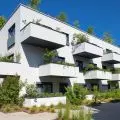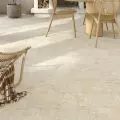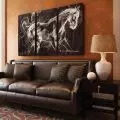All in green, technologically advanced, blended into the surroundings building-hill. This is what Robert Konieczny's first realization in Poznan is supposed to look like. From the outside - very interesting and well thought-out. On the inside - correct. 55 apartments will be built on the site intended for a hotel. A hole in the law allows it.
Such a building, with most of the facade in the form of a vertical garden, does not yet exist in Poland. It will soon stand in Poznan's Winogrady district on Slavianska Street, close to the center, near the Citadel park. The so-called aparthotel, named Aura, will occupy a site on the edge of Posnania Sports Club's sports grounds, next to a small stadium, playing fields, a swimming pool building and devastated courts. The investor is Piotr Voelkel, a well-known entrepreneur, founder of the VOX Group, SWPS University, School of Form and Collegium da Vinci, among others. In Poznań, he has to his credit the construction of the iconic and award-winning Bałtyk office building (proj. MVRDV) and the adaptation of a neighboring historic printing house into a design center. More recently, he has been investing in residential projects.
Konieczny won with greenery
The aparthotel project by Robert Konie czny's well-known KWK Promes studio was selected several years ago in a closed competition. Now its construction is to begin (it is only one of two buildings that the original concept presented).
Visualization of the Aura aparthotel at Słowiańska Street in Poznań, designed by Robert Konieczny, KWK Promes - view from the northwest, alleys lead towards Słowiańska Street, in the background the greenery of Cytadela Park, on the left, outside the frame: the Wilczak streetcar loop
© Robert Konieczny, KWK Promes
What determined the victory of the famous architect with an esteemed track record, whose realization in Ostrava, Czech Republic, was recently in the final five of the Mies van der Rohe Award? The biggest distinguishing feature of the four-story building is to be its completely green walls, overgrown with 140,000 plants. Also unique is its shape, which, according to the designers, stems from the idea that the
lump of the building grows out of the existing pile of land and, as it were, is an extension of it, creating a green hill. Users of the entire building can thus be in direct contact with the greenery, available at their fingertips as soon as they step out onto the terrace or loggia of each floor.
In fact, the soft lines of the building fit very successfully into the hilly terrain, and the green facades blend in with the surroundings. What will the green facades look like in detail? The architects inform:
Plants will grow here on a special structure, creating a vertical garden. A kind of air cushion will be created between it and the facade , which will be a natural insulator, protecting primarily against the heating of the building during hot weather. The greenery will be watered by an automatic system using retention water collected on the plot. The automation will minimize traditional maintenance by human hand. Plant irrigation will be 90% from filtered rainwater and snowmelt. The watering system will be powered by photovoltaic panels located on the roof.
Visualization of the Aura aparthotel at Słowiańska street in Poznań, designed by Robert Konieczny, KWK Promes - view from the north, from above Słowiańska street (hidden behind the frame at the bottom), on the right you can see a fragment of KS Posnania swimming pool
© Robert Konieczny, KWK Promes
microclimate for aparthotels
We also learn that scientists from the Poznan University of Technology and the University of Life Sciences have been involved in developing effective technical systems . The native species to appear on the facades were tested for two years on a special mo ck-up of a section of the wall on a scale of 1:1. In this way, the plants most resistant to changes in weather conditions and requiring the least care were selected. The authors of the concept mention that the walls are to form a "self-sustaining system." Unfortunately, we were unable to obtain photos from the developer showing these interesting tests on the mockup. So, for the sake of a snack, we quote the designers' assurances that
The unique façade system allows not only to regulate humidity and air temperature inside the building, but also in the immediate environment. This is architecture that realistically affects living conditions through a favorable microclimate.
The building-hill will certainly fit aptly into the green, though currently neglected, surroundings. The visualizations already show the target shape of the neighborhood, full of orderly greenery, with alleys and small architecture. However, they don't show much sporty development of the adjacent open areas (only one shows a section of the grandstand). The aparthotel, meanwhile, will be built on an area that was designated for sports and recreation services in the 2010 local zoning plan . Its construction is possible because the local development plan designates a "hotel location zone" - with the possibility of erecting a four-story building.
The grounds of KS Posnania on Slowinska Street in Poznan - view of the stadium from the hill on the side of Slowinska Street
photo: Jakub Głaz
The intention of the councilors and planners was for the hotel to provide facilities for the activities of the sports club. At that time there was not yet in Poland the now widespread practice of building "aparthotels," with separate units for sale. Formally they are not apartments, but - if the owner so desires - they can serve such a function as well (and not just premises for long-term rent). However, VAT is higher on the purchase (23, rather than 8%), which , as the investor helpfully suggests to purchasers of the units in Aura, "predisposes them to business purchases." To make hotel formalities a breeze, he assures that the building will have a "representative lobby with a professional concierge."
Local zoning plan for, among other things, the KS Posnania site - allowing hotel services marked with yellow gray in the US area, the northern boundary of the plan is Słowiańska Street
Source: Urban Planning Studio Poznań
Thus, everything is done in accordance with the law (more with the letter than its spirit), which in this regard urgently needs to be corrected. "Aparthotels", even if - as in this case - they present a high level of architecture, for they contradict the planners' intentions. We recently described the intention to build such, less successful, facilities at Poznań's Lake Malta, on a site earmarked for a hotel that was to serve the neighboring aquapark.
The site of KS Posnania on Slavianska Street in Poznan - lobby
© KWK Promes/mode:rope
the comfort of five entrances
So it's time to take a look inside Konieczny's Poznan project and take a closer look at the "apartments" (projections available on the investment's website). There will be 55 of them in the building - from 34-square-meter ones, measuring 70 square meters, to those reaching 160 square meters. The largest, two-story ones will be on the top floors. The building is also to include an "intimate spa" with a sauna, a bicycle room and a "do-it-yourself room." The underground garage will likely meet the MPZP's requirement that "for every 100 hotel beds [there will be] 50 parking spaces for cars." However, while from the outside the building, its integration into the terrain and the care taken to test the target solutions should be rated very highly, the inside is already weaker, although the authors of marketing communications do a lot to show that here too we are dealing with the premium category:
The developer makes no secret of the fact that the prices of apartments in Aura are above the market average for Poznań, but they reflect the real values represented by the investment. [...] Aura is an innovative project not only because of the building's architecture. The investor has also placed a strong emphasis on the comfort of apartment owners. Although the building is intimate, it has as many as five entrances with elevators. The purpose of such an arrangement is convenience and intimacy. On each floor there are doors to up to four apartments.
In short, nothing extraordinary. As for the number of apartments serviced by a single staircase, there is a return here to the standards often found in ordinary residential housing as recently as fifteen years ago - for example, in the housing estate in Wilczak, less than a kilometer away (2003-2007, investor Budimex/now: Spravia, designed by Kostka Kurka Architekci). More: in Poznań, a similar solution (also with an elevator in each staircase!) can be found in a very good cooperative development complex Rondo on Grunwaldzka Street(early 1960s).
aparthotel Aura at Słowiańska Street in Poznań, designed by Robert Konieczny, KWK Promes - floor plan
© Robert Konieczny, KWK Promes
And how can the apartments be evaluated? Their layouts are decent, but they rather lose out, for example, to the more functional plans of apartments both from "Rondo" and from the 1976-90 period in Poznań neighborhoods: in Piątkowo and in the eastern part of Rataj. Suffice it to note that in a significant part of the units from Slaviańska, typical contemporary kitchen "annexes" were designed, that is, simply dark kitchens, without the possibility of separation with an independent window. Instead, the double-sided lighting of the larger apartments, which is, again, a basic standard of the late communist era, is pointed out as a very favorable feature. Aura's floor plans, therefore, look good mainly against the background of contemporary "real estate development" with its corridors and terrible room layouts. The investment's location, however, is so favorable that , as Poznan's Gazeta Wyborcza found , one can demand between 23 and 32 thousand zlotys per square meter (in developer condition!).
Zięta on the cage
Thus, the investor's declared "aluminum windows," video intercoms, underfloor heating and (in some units) - the presence of two balconies, which "enjoy light from two sides of the world," can be considered a perk of this standard. In addition, in what is expected to be a strong differentiator of the investment, Aura will feature contemporary art, which is in line with Piotr Voelkel's activities as an art collector and patron of artistic activities:
To design the interiors, the investor invited Alicja Biala, a well-known artist in Poznań, author of the colorful "Totems" standing between the Sheraton Hotel and the Baltic Sea. For Aura, the artist designed an original ceramic plant sculpture-lamp in the lobby space, as well as a relief referring to the relationship between man and nature.
The staircases, in turn, will feature works by Oskar Zięta. The Poznan-based mode:lina studio is responsible for the overall design of the common spaces. The building is expected to be ready in early 2026.
KS Posnania grounds at Slavianska Street in Poznan - view from the place where Aura will stand towards KS Posnania swimming pool and Pod Lipami housing estate
photo: Jakub Głaz
Will the second facility envisaged by the competition concept be built next door? As Karolina Koziolek, representing Piotr Voelkel , president of the Vox-Artis Foundation, informs us, for now there are no such plans. Probably because the MPZP allows the construction of only one hotel, and another building could not serve as an apartment building. Will the planning situation change in the future? For now, there are no such signs, but the KS Posnania area is a very greedy morsel. More than a year ago, another investor proposed a rather intensive development of the southwestern part of the club's former sports grounds. Residents, however, strongly protested the attempts to change the MPZP.
















































